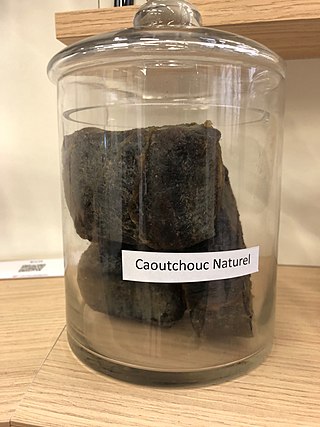
Rubber, also called India rubber, latex, Amazonian rubber, caucho, or caoutchouc, as initially produced, consists of polymers of the organic compound isoprene, with minor impurities of other organic compounds. Thailand, Malaysia, Indonesia, and Cambodia are four of the leading rubber producers.

Chlorobenzene is an aromatic organic compound with the chemical formula C6H5Cl. This colorless, flammable liquid is a common solvent and a widely used intermediate in the manufacture of other chemicals.

The Nocardiaceae are a family of aerobic, non-fastidious, high G+C, Gram-positive actinomycetes that are commonly found in soil and water. Members of this family have been isolated from Antarctic soils. Nocardiaceae present coccobacilli, filamentous or, rarely, fragmented and palisading forms, and filamentous species grow in a branching morphological pattern similar to fungal hyphae.
Rhodococcus erythropolis is a bacterium species in the genus Rhodococcus. It is Gram-positive. R. erythropolis has been isolated from the air of the Russian Space Laboratory Mir along with a large number of other microorganisms that steadily accumulated during the lifespan of the station. Rhodococcus bacteria are known to degrade organic compounds contained in the rubber used aboard the space station with specialized enzymes. This can lead to degradation of critical components and necessitates replacement of the parts or preventive measures dealing with microbial contamination.
Gordonia westfalica is a rubber-degrading actinomycete bacterium. It is aerobic and Gram-positive, with type strain Kb2T.
Gordonia is a genus of gram-positive, aerobic, catalase-positive bacterium in the Actinomycetota, closely related to the Rhodococcus, Mycobacterium, Skermania, and Nocardia genera. Gordonia bacteria are aerobic, motile, and non-sporulating. Gordonia is from the same lineage that includes Mycobacterium tuberculosis. The genus was discovered by Tsukamura in 1971 and named after American bacteriologist Ruth Gordon.. Many species are often found in the soil, while other species have been isolated from aquatic environments. Gordonia species are rarely known to cause infections in humans.
Pseudonocardia asaccharolytica is a dimethyl disulfide-degrading actinomycete, with type strain DSM 44247T.
Pseudonocardia sulfidoxydans is a dimethyl disulfide-degrading actinomycete, with type strain DSM 44248T.
Gordonia amicalis is a dibenzothiophene-desulphurizing actinomycete with type strain IEGMT.
Gordonia alkaliphila is a Gram-positive, aerobic and non-motile bacterium from the genus of Gordonia which has been isolated from tidal flat sediments from the Yellow Sea in Korea.
Gordonia alkanivorans is a bacterium from the genus of Gordonia which has been isolated from soil which was contaminated with tar and phenol in Rositz in Germany. Gordonia alkanivorans has the ability to metabolize hexadecane. The strain RIPI90A of Gordonia alkanivorans can desulfurize dibenzothiophene.
Gordonia cholesterolivorans is a bacterium from the genus Gordonia which has been isolated from sewage sludge from a sewage treatment plant in Ciudad Real in Spain. Gordonia cholesterolivorans has the ability to degrade cholesterol.
Gordonia defluvii is a Gram-positive and non-motile bacterium from the genus Gordonia which has been isolated from activated sludge foams in Australia.
Gordonia desulfuricans is a benzothiophene-desulphurizing bacterium from the genus Gordonia which has been isolated from soil from West Calder in Scotland.
Jongsikchunia kroppenstedtii is a bacterium from the genus Jongsikchunia which has been isolated from polluted stream in Gumi, Korea. Jongsikchunia kroppenstedtii has the ability to degrade phenol.
Gordonia namibiensis is a bacterium from the genus Gordonia which has been isolated from soil from Kalahari in Namibia. Gordonia namibiensis metabolises nitrile.
Gordonia neofelifaecis is a bacterium from the genus Gordonia which has been isolated from faeces from the leopard in the Sichuan Province in China.
Gordonia paraffinivorans is a bacterium from the genus Gordonia which has been isolated from the Daqing Oil Field in China. Gordonia paraffinivorans has the ability to degrade hydrocarbon.
Gordonia soli is a bacterium from the genus of Gordonia which has been isolated from soil in Taiwan.
Gordonia sp. nov. Q8 is a bacterium in the phylum of Actinomycetota. It was discovered in 2017 as one of eighteen new species isolated from the Jiangsu Wei5 oilfield in East China with the potential for bioremediation. Strain Q8 is rod-shaped and gram-positive with dimensions 1.0–4.0 μm × 0.5–1.2 μm and an optimal growth temperature of 40 °C. Phylogenetically, it is most closely related to Gordonia paraffinivorans and Gordonia alkaliphila, both of which are known bioremediators. Q8 was assigned as a novel species based on a <70% ratio of DNA homology with other Gordonia bacteria.


